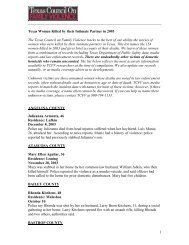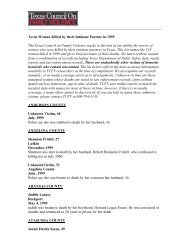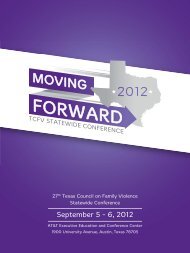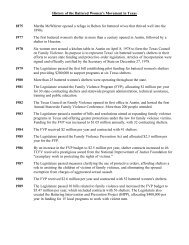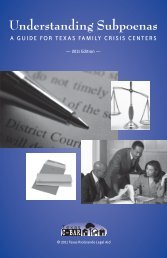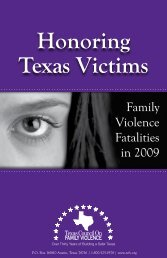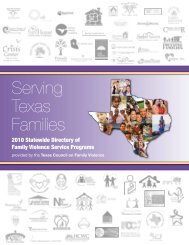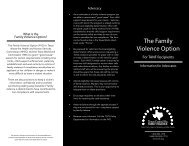the essential guide - Texas Council on Family Violence
the essential guide - Texas Council on Family Violence
the essential guide - Texas Council on Family Violence
You also want an ePaper? Increase the reach of your titles
YUMPU automatically turns print PDFs into web optimized ePapers that Google loves.
Chapter 8: Coordinati<strong>on</strong> of CommunityResp<strong>on</strong>se (CCR) to <strong>Family</strong> <strong>Violence</strong>In this chapter you will: Review <str<strong>on</strong>g>the</str<strong>on</strong>g> dynamics of <str<strong>on</strong>g>the</str<strong>on</strong>g> CCR and an introducti<strong>on</strong> to <str<strong>on</strong>g>the</str<strong>on</strong>g> Duluth Model. Identify roles and resp<strong>on</strong>sibilities of community partners in a CCR. Review benefits of CCR to family violence.A CCR to <strong>Family</strong> <strong>Violence</strong> brings criminal justice pers<strong>on</strong>nel, family violence advocates, and o<str<strong>on</strong>g>the</str<strong>on</strong>g>rcommunity members toge<str<strong>on</strong>g>the</str<strong>on</strong>g>r to protect victims and hold offenders accountable. Historically, <str<strong>on</strong>g>the</str<strong>on</strong>g>seefforts have led to pro-arrest policies, victim-oriented prosecuti<strong>on</strong>, judicial oversight of offenders,probati<strong>on</strong> m<strong>on</strong>itoring and coordinati<strong>on</strong> with victim services.The CCR model was pi<strong>on</strong>eered by <str<strong>on</strong>g>the</str<strong>on</strong>g> Domestic Abuse Interventi<strong>on</strong> Project (DAIP), also referred to as <str<strong>on</strong>g>the</str<strong>on</strong>g>“Duluth model.” DAIP is an interagency program c<strong>on</strong>ceived and implemented in Minnesota in 1980. TheCity of Duluth was identified as <str<strong>on</strong>g>the</str<strong>on</strong>g> best city to try to bring criminal and civil justice agencies toge<str<strong>on</strong>g>the</str<strong>on</strong>g>r towork in a collaborative way to resp<strong>on</strong>d to family violence cases. Eleven agencies were initially identifiedto collaborate: 911, police, sheriff’s and prosecutor’s offices, probati<strong>on</strong>, <str<strong>on</strong>g>the</str<strong>on</strong>g> criminal and civil courts, <str<strong>on</strong>g>the</str<strong>on</strong>g>local battered women’s shelter, three mental health agencies and a newly created coordinatingorganizati<strong>on</strong> called <str<strong>on</strong>g>the</str<strong>on</strong>g> DAIP.DAIP* philosophy indicates: The primary resp<strong>on</strong>sibility of placing c<strong>on</strong>trols <strong>on</strong> abusers bel<strong>on</strong>gs to <str<strong>on</strong>g>the</str<strong>on</strong>g> community and <str<strong>on</strong>g>the</str<strong>on</strong>g>individual abusers, not <str<strong>on</strong>g>the</str<strong>on</strong>g> victims of abuse. Battering is a form of family violence that entails a patterned use of coerci<strong>on</strong> and intimidati<strong>on</strong>,including violence and o<str<strong>on</strong>g>the</str<strong>on</strong>g>r related forms of abuse, whe<str<strong>on</strong>g>the</str<strong>on</strong>g>r legal or illegal. Initiatives must distinguish between, and resp<strong>on</strong>d differently to, domestic violence thatc<strong>on</strong>stitutes battering and cases that do not, and adjust those interventi<strong>on</strong>s to <str<strong>on</strong>g>the</str<strong>on</strong>g> severity of <str<strong>on</strong>g>the</str<strong>on</strong>g>violence. Interventi<strong>on</strong>s must account for <str<strong>on</strong>g>the</str<strong>on</strong>g> ec<strong>on</strong>omic, cultural and pers<strong>on</strong>al histories of <str<strong>on</strong>g>the</str<strong>on</strong>g> individualswho become abuse cases in <str<strong>on</strong>g>the</str<strong>on</strong>g> system. Both victims and offenders are members of <str<strong>on</strong>g>the</str<strong>on</strong>g> community; while <str<strong>on</strong>g>the</str<strong>on</strong>g>y must each act to change<str<strong>on</strong>g>the</str<strong>on</strong>g> c<strong>on</strong>diti<strong>on</strong>s of <str<strong>on</strong>g>the</str<strong>on</strong>g>ir lives, <str<strong>on</strong>g>the</str<strong>on</strong>g> community must treat both with respect and dignity andrecognize <str<strong>on</strong>g>the</str<strong>on</strong>g> social causes of <str<strong>on</strong>g>the</str<strong>on</strong>g>ir pers<strong>on</strong>al circumstances.*Adapted from www.<str<strong>on</strong>g>the</str<strong>on</strong>g>duluthmodel.org.An effective CCR draws up<strong>on</strong> <str<strong>on</strong>g>the</str<strong>on</strong>g> strengths of each community entity and identifies opportunities forcross-training and collaborati<strong>on</strong>. Here are a few examples of what different community entities can do:THE ESSENTIAL GUIDE: AN INTRODUCTION TO ADVOCATING FOR SURVIVORS OF FAMILY VIOLENCE58 | P a g e



